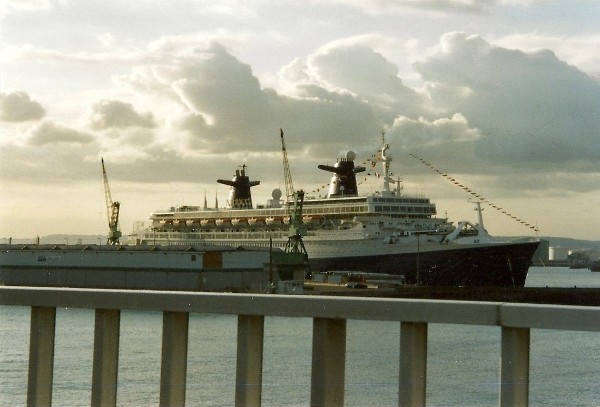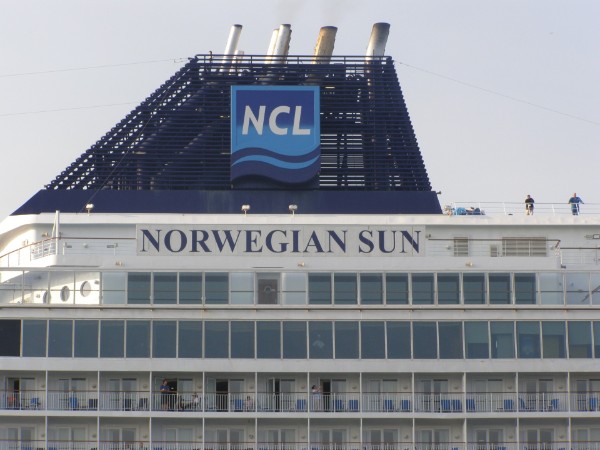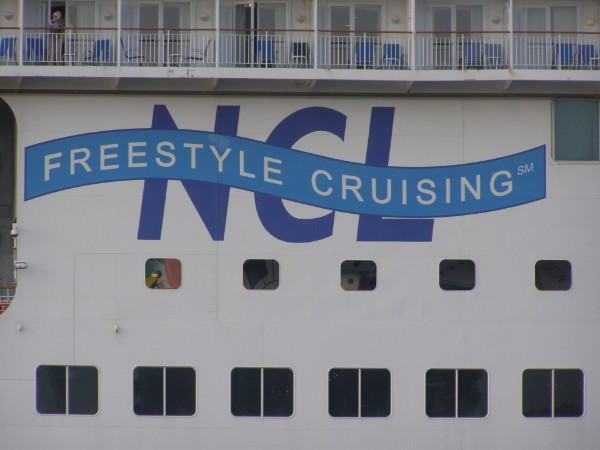Norwegian Cruise Line
Kloster's and the ferries
Norwegian Cruise Line has its origins in a company named Klosters Rederi, yes, from Norway. This company, headed by Knut Utstein Kloster, was founded in 1924 by Knut's grandfather for bulk- and tankershipping. In 1959, Knut Kloster entered the business and under his supervision, the company entered the passengertrade. In 1964, a company named Thoresen Car Ferries was started up by Otto Thoresen, one of Kloster's partners. Kloster himself also wanted to open a carferryline, and where Thoresen concentrated on connections between Southampton, and Cherbourg and Le Havre, Kloster wanted to start up a longer line between Southampton via Spain and Lissabon to the English enclave of Gibraltar. He followed the principle of Thoresen, who had started his service with two splendidly modern ferries, Viking I and Viking II, much more stylish then the older ferries on other route's. For the new line, Kloster also wanted to have a ferry that was capable of a comfortable trip for the long journey and he hoped to advertize the crossings as cruises, as well as a carferryservice. For the line, he thus had ordered a car ferry that was built in Bergen, Norway in 1966 named Sunward, a name chosen because the English could go 'to the sun' in Spain with the new ship. With a tonnage of 9000, the ship was at the time the largest ship ever built in Norway. The company targeted for lorrydrivers as well as holidaymakers and the ship therefore had a lot more to offer the passengers then other ferries. But there were some problems, because Spain was a fascist country headed by General Franco, and because Franco had closed the border between the British rock of Gibraltar and Spain, the route could not be operated as planned. So Kloster had a ship but no route, but this was changed when he was approached by a man named Edwin Stephan from Florida, who had been owner of the just defunct Pan American Cruise Line. He had used a ship, the old Egyptian ferry Nili, that he had chartered out to a man named Ted Arison. Because Pan American had gone bankrupt and the ship was laid-up, Arison was in desperate need for another ship because he had a lot of passengers that wanted to sail his popular Miami-Haïti-Jamaica service.

Norway seen at the Pointe de Floride quay at Le Havre at the 13th of september 2001. She was the first megaship sailing the Caribbean, starting cruises in 1980.
The Kloster and Arison combine/ The early NCL
Stephan and Kloster did not agree on the terms, but Kloster got also in touch with Arison, and they decided to combine forces and so the co-operation between Stephan, who later co-founded Royal Caribbean, and Arison ended and was replaced by the new venture, called Norwegian Caribbean Line. In this new venture, Kloster was the CEO and Arison took care of the promotion and passengers. The Sunward was replaced to Caribbean cruiseservice and became an instant succes. Her first cruise from Miami, a place formerly known for it's high crimerate and fishingfleet, started at the 19th of december 1966. For cruise-historians, this date is recognized as the start of the modern cruise-industry. Within some years, new ships had been ordered in Germany, that were designed as true cruiseliners to the same profile as the Sunward, yet bigger. At that moment, NCL was the leading cruiseline in the Caribbean. In 1971, it became clear that Arison and Kloster had different ideas about how to run the line as well as finances, so the two parted and Arison left the company. But don't worry about him, he set up a company of his own and his story can be found here. He ended up quite well, actually...

Growing fleet and wild plans
A fierce competition started to unveal in the Caribbean, after Norwegian Caribbean Lines, Carnival Cruise Lines (that was of course Arisons new toy), Royal Viking Line, Royal Caribbean Cruise Line and several others all wanted a piece of the pie. Most of these new companies were Norwegian owned or had a Norwegian background, but the only one to use the name of the home country was Kloster. In 1979, he hit the jackpot when he bought the former transatlantic liner and at the time the largest passengership in the world, the former France. The ship had been in lay-up since 1974 and Kloster saw a huge potential to outdo his rivals. In 1980, the ship was only to have one name, and she entered service as Norway, a vessel that was three times as large as any cruiseship then in Caribbean service. It was thought that the giant ships of the transatlantic age were unsuitable for the new role that they had to play, but Norway was an instant succes and she paved the way for large purpose-built cruiseliners. As NCL was becoming a real world leader, the company was awarded with the possibility to fly the flag of the United Nations on Norway, something that no other ship ever was able to do. So Norway really started it all, and Kloster was the big man in Miami at the time. With the success of the Norway in mind, Kloster also started to try and create the impossible, when he came up with the Phoenix/ America World City project in the 1990's. This was to be a very ambitious ship, over 250.000 tons and looking like an aircraft-carrier type of hull with three towering blocks of superstructure on top. Between the three towers, the main deck would be filled with restaurants, a park and swimmingpools. Of course the appartments (cabins would be too easy) would all have balconies and because the ship was simply too wide and big passengers had to be tendered ashore.
But in the 1990's, this ambition was way too high and the ship was never built, although in ship-designer perspective she is probably still the most talked about ship that has never been there. Or has she? When we now say towering blocks of cabins on top of a flat hull with a park and pools in between, creating the biggest ship ever of around 250.000 tons? It sound very much like Oasis Of The Seas and her sisters. As groundbreaking this Genesis-class of Royal Caribbean International from the 2000's may seem, the idea was in fact much older and introduced to the world by good old Knut Kloster in the early 1990's.

Freestyle cruising, a new way of cruising introduced by Norwegian Cruise Line in 2001, aboard their first freestyle-designed ship the Norwegian Sun. The goal of this is to have the passenger really enjoying their holiday by offering a lot of dining options, very relaxing atmosphere and to let them really do what they like at times they like to do it. NCL threw overboard the somewhat traditional 'rules' of cruising because they found that these rules spoiled the true holidayfeeling from the passengers.
Growth and gloom
Four years after the introduction of Norway, Kloster aquired another company, also from Norway, the very upmarket Royal Viking Line. He did not merge it into his own company, it stayed independent. At least, for the time being. In 1990, also the Royal Cruise Line was bought, including their one-ship operation. But financially, it was a different story. Klosters rivals had all built large, new ships to compete with the succes of Norway and Kloster was no longer unique with his great, but old ship. Financial cracks began to appear and he had to close and sell Royal Cruise Line and Royal Viking Line to keep NCL afloat. In 1987, Kloster Cruise, the parent of all of the lines, was renamed to VARD A/S. For the companies, this did not have many consequences yet.
A new dawn/ modern times
In 1997, the main fleet of Norwegian Caribbean Lines adopted a new name, although the initials were still the same. They became Norwegian Cruise Line. Also in the late 1990's, NCL was bought by a joined venture between Star Cruises from Malaysia and Carnival Cruise Lines, the company started up by Ted Arison. Carnival was way better financially equipped and so finally, Kloster finally had lost the battle. The rest of VARD now is a company largely owned by Fincantieri and specialized in design and shipbuilding for offshore and gas-specialized ships. In 2000, Carnival backed out and Star Cruises became the sole owner. But financially, NCL was still not a success although a lot of new ships and a totally new theme, Freestyle Cruising, had been introduced. In 2007, Star Cruises sold 50% of its shares in NCL to Apollo Management, together with the management of the company. Under Apollo management, it seems NCL is finally getting their financials right again the last years and with one of the most modern fleets in the world after losing older tonnage, NCL is back on track. With the new fiancial backing, NCL started a big fleet expansion with very large ships. When the first of those, the 155.000 ton Norwegian Epic entered service, she was the 6th largest cruiseship ever built. She was followed by the 145.000 ton two-ship Breakaway-class and a still larger class of four ships is about to enter service within the next years, known as the Breakaway-+ class, with one extra added deck to the original duo.
On the 2nd of september 2014, it was announced that Norwegian Cruise Line had bought the Prestige Cruises holding, including its two lines Oceania Cruises and Regent Seven Seas Cruises. Both lines will be branded without change under the new ownership.
Other ships that have sailed for NCL but are placed in other sections on this site are listed below
Starward (1968-1995) is placed under Louis Cruises as Louis Aura
Sunward II (1997-1991) is placed under Cunard Line as Triton
Westward (1991) is placed under Fred. Olsen as Black Watch
Sunward (1991-1993) is placed under Fred. Olsen as Boudicca
Norwegian Crown (1996-2000 and 2003-2006) is placed under Fred. Olsen as Balmoral
Norwegian Dynasty (1997-1999) is placed under Fred. Olsen as Braemar
For booking information, visit the website of Norwegian Cruise Line.

